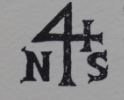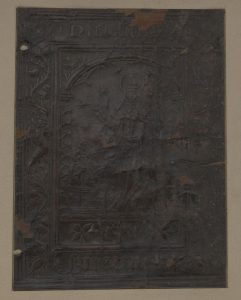Wyverns, gryphons and acorns amidst the foliage: two rare early 16th century bindings by Nicholas Spierinck uncovered in the Rare Books Collection
What makes working with rare books so intriguing is the opportunity it delivers to follow a trail of clues – Sherlock Holmes-like – to trace an object’s origin and story through time. Two excised bindings recently located in the Rare Book Room, have inspired one such stimulating pursuit…
An intact Spierinck binding
In 2008 the Baillieu Library was excited to purchase a rare original intact binding by the early Cambridge stationer Nicholas Spierinck, generously funded by the Ivy May Pendlebury Bequest. The beautifully tanned calfskin cover encases a 1512 Paris edition of the works of 3rd-century Christian theologian, Origen Adamantius (b.184/185 – d.253/254), entitled Origenis Adamantii Operum tomi duo priores… . At the time of the book’s acquisition, it was (and remains) the only known example of a complete Spierinck binding held in an Australian institution, bearing his personal binder’s mark, and incorporating his signature decorative schema of wyverns, gryphons and acorns. A former Baillieu Library Rare Books Curator, Pam Pryde, described this unique acquisition and binding in her December 2008 Collections magazine article. An animated 3D view of the binding, providing close inspection of Spierinck’s monogram and decorative devices is available here.
Two dis-bound Spierinck cover panels
In a recent intriguing twist to the tale, an uncatalogued box of bindings in the Rare Books Collection has been found to contain a pair of rare dis-bound Spierinck covers, together with 13 binding fragments from other provenances and time periods. It appears that the samples were amassed by an unidentified donor, as a study collection for research and teaching. The envelopes containing the two Spierinck bindings are clearly marked with his name in a 20th century hand; this attribution is conclusively confirmed by the presence of Spierinck’s distinctive stamp on both panels, which match exactly with those on the intact Origenis binding.
At first inspection, it is unclear whether the two dis-bound panels came from the same or different books, as one has been cut down in size and is 15mm smaller on each side than the other. A shared provenance, however, seems very likely as both specimens bear pin holes at the same points, where the clasp and straps used to latch the panels would have once been attached to the covers, front and back.
16th century Cambridge book trade
In the early 16th century, the inland port of Cambridge was well placed to service its university’s growing appetite for books, being situated on an established river trading route, 40 miles from the Channel. At this time, the majority of foreign language books (including the bulk of scholarly works which were written in Latin) were printed on the continent, and imported into England in loose form for binding and sale. The burgeoning print market attracted foreign traders who set up mixed commercial enterprises as stationers, variously dealing in the importation, sale and binding of books.[i] Many of these European artisans had migrated from the major book production centres of Paris, Basel and the lower Rhine, bringing their craft skills and ornamental influences with them.[ii] The first University of Cambridge printer, John Siberch (c1476–1554), was an established member of the German book trade before settling in the English town, where he operated from 1520-1522.[iii]
Nicholas Spierinck, fl. 1505-d.1545-6
With the passing of the centuries the names of most early English binders have passed into obscurity. These anonymous ghosts are known today by their evocative decorative devices, such as ‘the fruit and flower binder’, ‘the fishtail binder’, ‘the half stamp binder’, ‘the huntsman binder’, ‘the octagonal rose binder’, ‘the blank book binder’, and – my favourite – ‘the bat binder’.[iv] The historical record is much clearer for Nicholas Spierinck, as his appointment on 20th July 1534, as one of three official stationers (with Garrett Godfrey and Segar Nicholson) to the University of Cambridge, ensured that his name was inscribed in the official registers for posterity.[v]
Nicholas Spierinck, a member of a Netherlandish family of stationers, arrived in Cambridge sometime between 1503 and 1506, a binder of the same name having worked for Charles the Bold, Duke of Burgundy between 1469 and 1475. By 1516 Spierinck held the office of warden at St Mary’s Church in the centre of Cambridge, and his will (dated 20th August 1545) confirms that he became a successful merchant and a citizen of some standing. He bequeathed a brewery at Cross Keys to his grandson Nycholas (which was still in operation in 1915), silver and coral beads to his wife Agnes and ‘Kateryn’ (probably his daughter) and the residue of his estate to his son, ‘William Spyrynke’, who had by that time taken charge of the family book binding operations.[vi]
Blind stamped binding
An expanding English book trade, injected with an influx of skilled foreign labour, could not help but be influenced by continental fashions in binding and manufacture. The outmoded medieval technique of decorating covers with hand-tooled patterns, gave way to the more efficient ‘blind stamping’ method (blind referring to the absence of gold). This system used heated metal block plates, commonly bearing pictorial designs, to impress decorations on the moistened leather panels.[vii]
The commercial potential of binding books in a ‘house style’ was exploited by binders and booksellers as an early form of corporate branding and advertising. Hence the practice adopted by different stationers to apply their trade mark panel to books sold from their premises. Blind stamped panel bindings were typically employed as pairs, with the same coupling used by binders on many books in their ‘stable’.[viii] There were an estimated 200 such panels in use in various combinations between 1485 and 1555.[ix]
The two newly-located Spierinck covers are examples of the two most commonly used panels associated with his workshop, which is known to have produced as many as 35 pressings of the upper panel (depicting The Annunciation).[x] As evidenced by all extant examples, it was always used by Spierinck in combination with the lower panel (depicting the legend of St Nicholas), illustrating the three boys who were cut up and pickled by an innkeeper and then restored to life by the passing saint. A black and white image of an intact Spierinck binding using this pairing of panels is reproduced in Gray’s The earlier Cambridge stationers & bookbinders and the first Cambridge printer.[xi]
In tandem with blind stamping, cylindrical hand rolls were used as labour-saving devices, to imprint decorative bands across the leather, often incorporating a binder’s or bookseller’s distinctive ornamental motif or signature.[xii] We are very fortunate to have a splendid example of Spierinck’s principal hand roll (he had six) in the decoration of the Origenis binding, which can be compared with the border patterns used on the blind cover panels.
Further investigation and analysis
As with many historical conundrums, some questions about the panels remain unanswered, and the fragments recently uncovered in the Rare Books Collection will benefit from further conservation and investigation. Both pieces of leather binding were removed from their original boards and pasted onto parchment mountings, sometime in the early 20th century. This has obscured the reverse of each panel and evidence of how the leather was cut and placed over the boards. Middleton notes in his history of English bookbinding techniques that Spierinck was one of the last binders to use corner-mitring to achieve a precise meeting of the turned leather edges at the inside corners. This technique involved the cutting of a ‘tongue’ which was incised after the leather had been turned over from the front of the board. The outstanding finish achieved using the method is evident in the Origenis binding, and it would be interesting to find evidence about how the corners of the dis-bound panel fragments were treated. [xiii]
Until this research can be undertaken, how curious it is to ponder that these three Spierinck examples, which emanated from the same workshop in 16th century Cambridge, should be reunited after travelling separate paths, and be housed several shelves away from each other at the University of Melbourne, some 500 years later.
Susan Thomas, Rare Books Curator
Endnotes
[i] Weale, p. xxix
[ii] McKitterick, p. x
[iii] Venn, p. 73. Incidentally, Siberch was a great friend of Erasmus, to whom he introduced Spierinck.
[iv] Oldham, 1952, p. x
[v] Weale, p. xxvii
[vi] Gray & Palmer, pp. 31-32
[vii] Middleton, pp. 168-9
[viii] Pearson, p. 50
[ix] Hobson, pp. [89]-90
[x] Oldham, pp. 19, 42
[xi] Gray, Plate XVI – Evangelia, 1508.
[xii] Harthan, p. 11
[xiii] Middleton, p. 151
Bibliography & further reading
British Library. Database of bookbindings. Accessed 10 March 2017 http://www.bl.uk/catalogues/bookbindings/
Gray, George & William Palmer. Abstracts from the wills and testamentary documents of printers, binders and stationers of Cambridge, from 1504-1699. London: Bibliographical Society, 1915.
Gray, George. The earlier Cambridge stationers & bookbinders and the first Cambridge printer. Oxford: Bibliographical Society, 1904.
Hobson, G.D. Blind-stamped panels in the English book-trade, c. 1485-1555. London; Bibliographical Society, 1944
McKitterick, David. A history of the Cambridge University Press. Volume 1. Printing and the book trade in Cambridge, 1534-1698. Cambridge: Cambridge University Press, c1992.
Oldham, J. Basil. Blind panels of English binders. Cambridge: Cambridge University Press, 1958.
Oldham, J. Basil. English blind-stamped bindings. Cambridge: Cambridge University Press, 1952.
Pearson, David. English bookbinding styles 1450-1800: a handbook. London: The British Library & Oak Knoll Press, 2005.
Pryde, Pam. ‘A recent purchase for Special Collections in the Baillieu Library’, University of Melbourne Collections, Issue 3, December 2008. Accessed 10 March 2017 http://museumsandcollections.unimelb.edu.au/__data/assets/pdf_file/0009/1378827/pryde.pdf
Sims, Liam. ‘An early Cambridge binding by Nicholas Spierinck’. Cambridge University Library Special Collections blog post, 3 April 2015. Accessed 10 March 2017 https://specialcollections.blog.lib.cam.ac.uk/?p=7461
Venn, John & J.A. Venn. Alumni Cantabridgienses: a biographical list of all known students, graduates and holders of officeat the University of Cambridge, from the earliest times to 1900. Cambridge: Cambridge University Press, 1927.
Weale, W.H. James. Bookbindings and rubbings of bindings in the Victoria and Albert Museum. London: The Holland Press, 1962.
Categories
- Uncategorised
- 16th century book binding
- Acorns
- animals
- Blind stamped panels
- Book binding fragments
- Book binding signatures
- botany
- Cambridge book binders
- Early English book binding
- Foliage
- Gryphons
- Netherlandish book binders
- Nicholas Spierinck
- Origen Adamantius
- Origenis Adamantii Operum tomi duo priores
- Rare Books
- Special Collections
- St Nicholas
- The Annunciation
- Wyverns




Leave a Reply